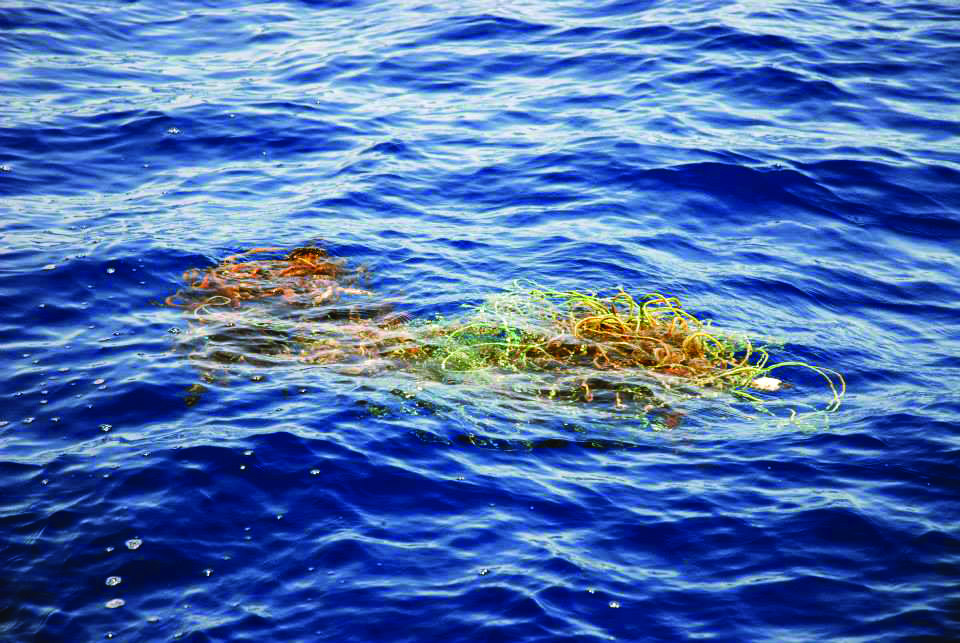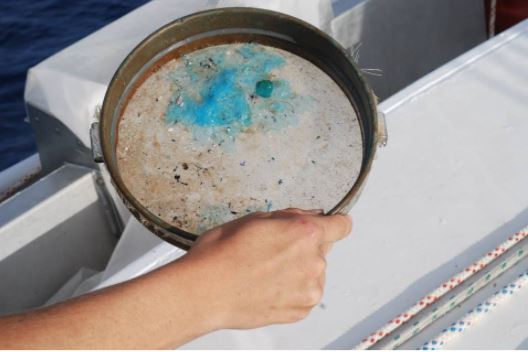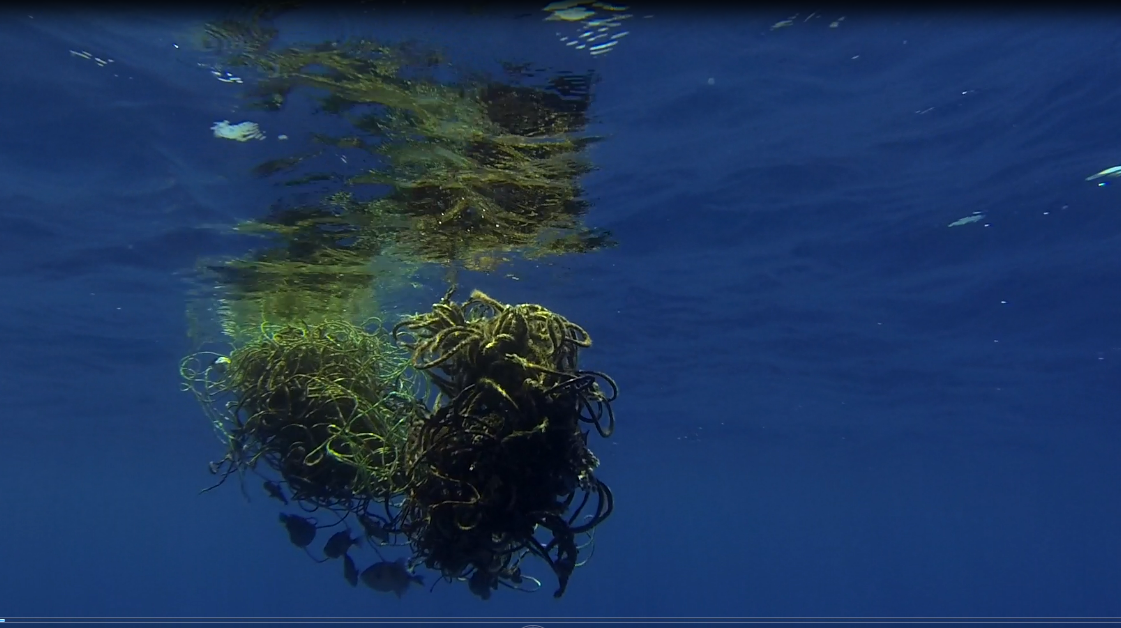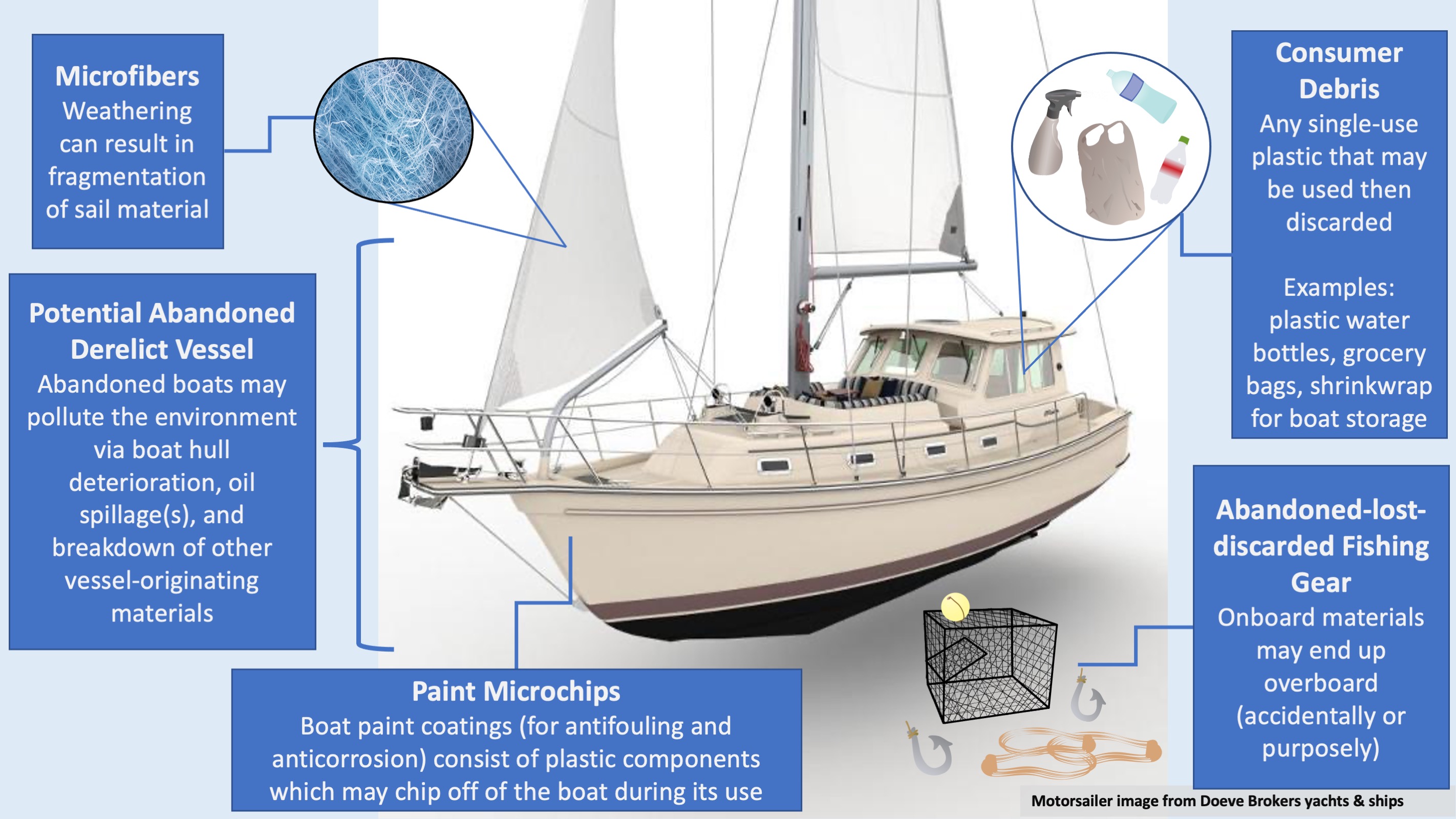At the dock, underway, or in the boatyard, pastics are all around sailors
Sailing connects us with nature. The Chesapeake Bay and its far-reaching tributaries tie us together as we race, cruise, and drop a hook. Our desire to enjoy the Bay waters instills a sense of responsibility to protect Bay health for generations of sailors to enjoy. As we sail, however, we are often disturbed by seeing floating plastic bottles—marine plastic pollution. Much of this does not come from boats. The vast majority of plastic in the oceans comes from the land where littered or poorly secured plastic items can be blown or carried by stormwater into the water. Whether at the dock, underway, or working in the boatyard, how we use and discard plastic products can help the reduction of marine plastic pollution.
Many sailors don’t think about it, but in addition to the plastic items we use everyday, we are in an age of synthetic sail. Starting around the 1950s, a plastic-dominant boating industry catapulted ahead. Nowadays, durable yet versatile plastic materials help us build our boats, maintain them, and enhance their performance and our comfort. In order to sail fast in a blow, we hoist sails of synthetic and plastic polymer composition. At the dock, we relax when our synthetic dock lines, plastic fenders, and rub rails keep our yachts secure.
Our acrylic-based canvas covers and awnings shield our sails, vinyl upholstery seat cushions, and the brightwork or fiberglass in the cockpit and on deck from direct exposure to the elements. Marine safety is also dominated by plastic products, such as onboard life rafts, lifejackets, tethers, foul weather gear, and foam life rings. Many of the items you pick up at the boat store are made of plastic. Tiny pieces of plastic, known as microplastics, can break off these items, as well as our boats, into the water and ocean. Do we need to rely on plastic materials to sail in the future?
We can make a big push to help moderate our plastic use, reduce marine plastic pollution, and take care of the Bay—as it takes care of us— by transforming our community into a green fleet of boaters! Scientists are just beginning to piece together how plastic pollution originating from land- and marine-based sources impact the Bay’s habitat and local wildlife, our economic livelihood, and our navigation safety. It’s unknown exactly how much plastic ends up in the Bay each year, but one thing is certain: it is going to take community commitment to keep plastic out of the water.
1. Commit To Sailing a Clean Bay by Carrying a State Boating License
Chesapeake watershed states require most mariners to have a valid boater safety certificate while operating any motorized vessel. This requirement reminds us to sail safely while the state can advise boaters on the latest ecologically relevant regulations and best practices to prevent marine plastic pollution associated with boating. Having a state boater education certificate serves as a commitment, as well as physical proof, that we are stewards for the marine environment for where we sail. The Maryland Department of Natural Resources (MDNR) gives boaters the opportunity to pledge their dedication to responsible, clean boating practices. Additionally, BoatUS gives the whole country full free access to a Clean Boater Course in order to heighten boater marine environmental awareness.
2. Endorse Certified Clean Marinas and Partners
While almost every state in the Chesapeake Bay watershed has a Clean Marina Program, Maryland also exhibits a Clean Marina partnership program for small-boat facilities to establish their commitment to marine environmental stewardship. Just ask your marina, yacht club, and/or boatyard if they are a certified Clean Marina or Clean Marina Partner. Stand by them if they are and encourage them as they work towards maintaining their Clean Marina status. Inform them of this opportunity if they are out of the loop!
As marinas go green, their leadership helps us jointly prevent marine plastic pollution across the Chesapeake Bay. Clean Marinas and Partners are more apt to know what materials can be recycled in their county and will offer receptacles if boaters follow their recycling guidelines carefully. In addition, these marinas often have a receptacle for monofilament fishing line and a boat shrinkwrap recycling service. These locations can advise boat owners on the latest state-advised best practices for careful cleaning and reapplication of boat paint, which is often an under-recognized source of microplastic discharge from plastic-based paint chips.

3. Support Green Boat Product Businesses with Product Recovery Options
Consignment stores, chandleries, pop-up boater flea markets, and social networks like eBay, Craigslist, and Facebook Marketplace are all great options to sell boat parts and encourage their reuse. Old sails can also be reused for bags or other accessories. So much of our plastic boat products become tossed in the dumpster, especially after moisture, mold, and UV rays tarnish their appearance. Boat product businesses need our encouragement to go green. New business strategies might include recovery-then-reuse of used boating products, leading to the reduction of new plastic, a decrease in waste, and opportunities to sell new products from used material. Boat manufacturers could begin programs to reclaim aged boats to harvest their fiberglass for reuse or to sell to construction businesses. Sailmakers can also move to recovery-reuse practices.
4. Decrease Boat Abandonment by Maintaining Boat Operability and by Increasing Boat Donation
It is always sad to pass by a beached or sunken sailboat. It’s also a bad day if you hit an abandoned boat by surprise while out cruising. All but one state in the Chesapeake Bay watershed has formed an Abandoned and Derelict Vessel (ADV) program. Storms and accidents happen, which may set them adrift. With an active state boat registration, boat insurance, a towing membership, and overall vigilance to promote boating safety, sailors can collectively demonstrate their pushback against avoidable ADV conflict and hazards. Donating your vessel is by far the best option for end-of-life boat disposal. Nonprofit organizations such as the Ocean Research Project and Chesapeake Region Accessible Boating are happy to accept donated boats. If you are boating and see another vessel adrift, please pick up the radio and report this hazard to the local U.S Coast Guard Unit.
5. Don’t Cut a Pot and Not Tell
Most of the year crab pots and other fishing gear are scattered throughout the Chesapeake Bay’s shallow waters. When cruising through a crab pot area, if your boat happens to become entangled with a crab pot and you need to cut it free, please report the event. Lost or ghosted crab pots have put a dent on the crab population, and even terrapin turtles are reported to have become trapped. Pots litter the Bay bottom, and while they deteriorate, microplastics from pot or cage coatings and associated line and buoys pollute the water and are ingested by marine life. Please report crab pot abandonment events to the Natural Resources Police to aid in pot recovery. This will reduce hazards to navigation and impacts to wildlife and the economy.
by Nicole Trenholm, Lauren Rodreguez, Nicholas Dawson, and Rui Xu
About the authors: Graduate students Nicole Trenholm, Lauren Rodriguez, Nicholas Dawson, and Rui Xu produced this article as part of an issue study group on plastic pollution taught by Research Professor Hellen Bailey and Professor Carys Mitchelmore at the University of Maryland Center for Enviornmental Science.
Editor's note: To report abandoned and derelict vessels, ghost pots, or hazardous vessel-related debris, in Maryland call the National Resource Police at (410) 260-888, and in Virginia call the Department of Wildlife Resources at (804) 367-1000.







